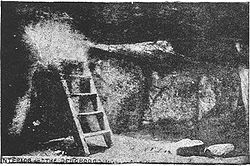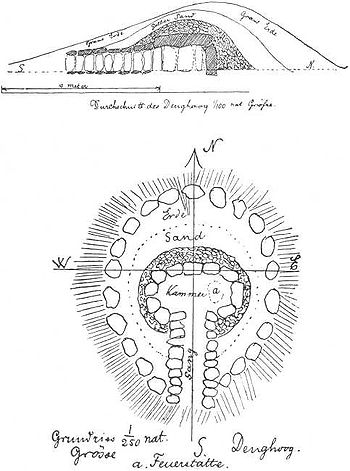
Denghoog
Encyclopedia

Wenningstedt-Braderup
Wenningstedt-Braderup is a municipality on the island of Sylt in the district of Nordfriesland, in Schleswig-Holstein, Germany...
on the German
Germany
Germany , officially the Federal Republic of Germany , is a federal parliamentary republic in Europe. The country consists of 16 states while the capital and largest city is Berlin. Germany covers an area of 357,021 km2 and has a largely temperate seasonal climate...
Island of Sylt
Sylt
Sylt is an island in northern Germany, part of Nordfriesland district, Schleswig-Holstein, and well known for the distinctive shape of its shoreline. It belongs to the North Frisian Islands and is the largest island in North Frisia...
.
Mr. W.G. Black speaks of it thus:—
- "There is some confusion as to King Finn's dwelling. As doctors differ, we may be allowed to claim that it was the Denghoog, close to Wenningstedt, if only because we descended into that remarkable dwelling. Externally merely a swelling green mound, like so many others in Sylt, entrance is gained by a trap-door in the roof, and descending a steep ladder, one finds himself in a subterranean chamber, some seventeen by ten feet in size [17 by 10 ft (5.2 by 3 m)], the walls of which are twelve huge blocks of Swedish granite;[Pg 72] the height of the roof varies from five feet to six feet [5–6 ft (1.5–1.8 m)]. The original entrance appears to have been a long narrow passage, 17 feet (5.2 m) long and about two feet wide and high. This mound was examined by a Hamburg professor in 1868, who found remains of a fireplace, bones of a small man, some clay urns, and stone weapons. Later, a Kiel professor is said to have carried off all he found therein to Kiel Museum, and so far we have not been able to trace the published accounts of his investigations."
Mr. Christian Jensen, of Oevenum
Oevenum
Oevenum is a municipality on the island of Föhr, in the district of Nordfriesland, in Schleswig-Holstein, Germany.-History:...
, Föhr
Föhr
Föhr is one of the North Frisian Islands on the German coast of the North Sea. It is part of the Nordfriesland district in the federal state of Schleswig-Holstein. Föhr is the second-largest North Sea island of Germany....
, gave this account of Denghoog:

Immediately after this excavation of 17–19 September 1868, C.P. Hansen writes as follows:—
- "'There are in the island of Sylt hillocks of ancient origin, for the most part pagan burying-places, but some of which may have served as the dwelling-places of a primitive people. One such hillock has just been opened at Wenningstedt. The interior was found to be a chamber, 17 feet (5.2 m) long, 10 feet (3 m) in breadth, and from 5 to 6 feet [1.5 to 1.8 m] in height, with a covered passage about 22 feet (6.7 m) long, trending southward. The walls of this underground room were composed of twelve large granite blocks, regularly arranged; the roof consisted of three still larger slabs of the same kind of rock; the stones which formed the passage were smaller. At one corner of the floor of the cellar there was a well-defined fireplace, and near it were urns and flint implements; in the opposite corner there were many bones lying, apparently unburned, probably those of the last dweller in the cavern.'"
- "... On the floor of the chamber, three separate divisions were distinctly visible, of which one, situated on the east side, showed traces of having been a fireplace. Professor Wibel found several fragments of human bones, which evidently belonged only to one individual, as no portion was duplicated; also a few animals' bones. There was an extraordinary number of fragments of pottery, belonging to about 24 different urns, of which 11 could be put together. Their form and ornamentation were both fine and varied, an interesting witness to the ceramics of the grey past.... Among the stone implements found were a great many flint-knives; two stone hatchets, two chisels, and a gouge, all of[Pg 74] flint, and a disc of porphyry were also obtained. Several mineral substances, quartzite, rubble-stones, gravel, ochre, a sinter-heap—these are less interesting than the seven amber beads which, with some charcoal, completes the list of objects found. Referring to former investigations of galleried mounds [gangbauten], which seem to have been used in some cases as burying-places, in others as dwellings, Dr. Wibel observes, in answer to the question resulting from his discovery, as to whether the Denghoog ought to be regarded as a sepulchre or as a dwelling, that, as Nilsson has already said, all gallery-mounds were originally dwellings, and occasionally became utilised as tombs. In the case of the Denghoog, this fact is demonstrated by the fireplace, the scattered potsherds, the amber beads, &c."

